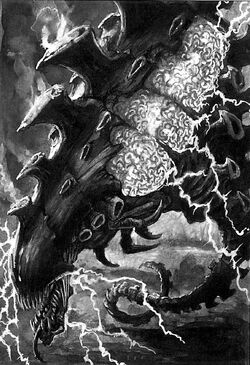(Adding categories) Tag: categoryselect |
No edit summary Tag: sourceedit |
||
| Line 1: | Line 1: | ||
[[File:Doom of Malan'tai - Zoanthrope.jpg|thumb|250px|A rare pict-capture of the Tyranid organism known as the Doom of Malan'tai]] |
[[File:Doom of Malan'tai - Zoanthrope.jpg|thumb|250px|A rare pict-capture of the Tyranid organism known as the Doom of Malan'tai]] |
||
| − | The so-called '''Doom of Malan'tai''' was a specially adapted [[Tyranid]] [[Zoanthrope]] organism that had the ability to feed upon the psychic energy and souls of its victims. It |
+ | The so-called '''Doom of Malan'tai''' was a specially adapted [[Tyranid]] [[Zoanthrope]] organism that had the ability to feed upon the psychic energy and souls of its victims. It played an instrumental role in the destruction of the entire [[Eldar]] population of the of [[Craftworld]] [[Malan'tai]]. |
==History== |
==History== |
||
The Eldar legend of the Doom of Malan'tai refers not only to the tale of an entire craftworld’s death, but also to the abominable Tyranid creature that caused it -- to the Eldar, the two are indistinguishable. The lament speaks of a Tyranid creature unlike any other, a beast that gorged not upon flesh and blood, but upon the life-force of its victims, leaving only soulless oblivion in its wake. The Doom of Malan'tai was an adaptation of the Zoanthrope, and its weak physical appearance belied its true horror. So it was that, when a lone, wounded bio-ship invaded [[Craftworld]] Malan'tai, the Eldar did not at first realise that the true threat lay not with the towering Tyranid monsters rampaging through their home, but with the unassuming creature left relatively unhindered to feed on Eldar souls. As it fed, the Doom of Malan'tai's power grew, the absorbed life-energy enhancing its fearsome psychic might. Once it had gorged on the spirits of the craftworld's [[Infinity Circuit]], it was nigh invulnerable, possessing the power to pulp Eldar warriors, snap [[Wraithbone]] war-constructs and shatter towering spires with cataclysmic bolts of psychic energy. It was all that the few Eldar survivors could do to escape Malan'tai, a craftworld found adrift in space years later, reduced to nought but a cold, lifeless shell. Of the loathsome creature that had brought about its destruction, there was no sign. |
The Eldar legend of the Doom of Malan'tai refers not only to the tale of an entire craftworld’s death, but also to the abominable Tyranid creature that caused it -- to the Eldar, the two are indistinguishable. The lament speaks of a Tyranid creature unlike any other, a beast that gorged not upon flesh and blood, but upon the life-force of its victims, leaving only soulless oblivion in its wake. The Doom of Malan'tai was an adaptation of the Zoanthrope, and its weak physical appearance belied its true horror. So it was that, when a lone, wounded bio-ship invaded [[Craftworld]] Malan'tai, the Eldar did not at first realise that the true threat lay not with the towering Tyranid monsters rampaging through their home, but with the unassuming creature left relatively unhindered to feed on Eldar souls. As it fed, the Doom of Malan'tai's power grew, the absorbed life-energy enhancing its fearsome psychic might. Once it had gorged on the spirits of the craftworld's [[Infinity Circuit]], it was nigh invulnerable, possessing the power to pulp Eldar warriors, snap [[Wraithbone]] war-constructs and shatter towering spires with cataclysmic bolts of psychic energy. It was all that the few Eldar survivors could do to escape Malan'tai, a craftworld found adrift in space years later, reduced to nought but a cold, lifeless shell. Of the loathsome creature that had brought about its destruction, there was no sign. |
||
Revision as of 21:56, 6 July 2016

A rare pict-capture of the Tyranid organism known as the Doom of Malan'tai
The so-called Doom of Malan'tai was a specially adapted Tyranid Zoanthrope organism that had the ability to feed upon the psychic energy and souls of its victims. It played an instrumental role in the destruction of the entire Eldar population of the of Craftworld Malan'tai.
History
The Eldar legend of the Doom of Malan'tai refers not only to the tale of an entire craftworld’s death, but also to the abominable Tyranid creature that caused it -- to the Eldar, the two are indistinguishable. The lament speaks of a Tyranid creature unlike any other, a beast that gorged not upon flesh and blood, but upon the life-force of its victims, leaving only soulless oblivion in its wake. The Doom of Malan'tai was an adaptation of the Zoanthrope, and its weak physical appearance belied its true horror. So it was that, when a lone, wounded bio-ship invaded Craftworld Malan'tai, the Eldar did not at first realise that the true threat lay not with the towering Tyranid monsters rampaging through their home, but with the unassuming creature left relatively unhindered to feed on Eldar souls. As it fed, the Doom of Malan'tai's power grew, the absorbed life-energy enhancing its fearsome psychic might. Once it had gorged on the spirits of the craftworld's Infinity Circuit, it was nigh invulnerable, possessing the power to pulp Eldar warriors, snap Wraithbone war-constructs and shatter towering spires with cataclysmic bolts of psychic energy. It was all that the few Eldar survivors could do to escape Malan'tai, a craftworld found adrift in space years later, reduced to nought but a cold, lifeless shell. Of the loathsome creature that had brought about its destruction, there was no sign.
Canon Conflict
According to Codex: Tyranids (5th Edition), the destruction of Malan'tai took place circa 808 or 812.M41. This conflicts with Codex: Grey Knights (5th Edition), as the Grey Knights supposedly encounter the ruin of Malan'tai in the aftermath of its destruction, in 800.M41.
Sources
- Codex: Tyranids (6th Edition), pp. 107-108
- Codex: Tyranids (5th Edition), pp. 16-17, 58
- Iyanden - A Codex: Eldar Supplement (6th Edition), pp. 11-12, 58
